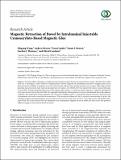Files in this item
Magnetic retraction of bowel by intraluminal injectable cyanoacrylate-based magnetic glue
Item metadata
| dc.contributor.author | Wang, Zhigang | |
| dc.contributor.author | Brown, Andrew | |
| dc.contributor.author | André, Pascal | |
| dc.contributor.author | Brown, Stuart | |
| dc.contributor.author | Florence, Gordon John | |
| dc.contributor.author | Cuschieri, Alfred | |
| dc.date.accessioned | 2014-02-25T15:01:02Z | |
| dc.date.available | 2014-02-25T15:01:02Z | |
| dc.date.issued | 2013-10 | |
| dc.identifier | 73617122 | |
| dc.identifier | fe0b5748-3393-4c6b-b9fa-d22e0bd0586e | |
| dc.identifier | 84890056006 | |
| dc.identifier | 000327350800001 | |
| dc.identifier.citation | Wang , Z , Brown , A , André , P , Brown , S , Florence , G J & Cuschieri , A 2013 , ' Magnetic retraction of bowel by intraluminal injectable cyanoacrylate-based magnetic glue ' , BioMed Research International , vol. 2013 , 526512 . https://doi.org/10.1155/2013/526512 | en |
| dc.identifier.issn | 2314-6133 | |
| dc.identifier.other | ORCID: /0000-0001-9921-4399/work/56638884 | |
| dc.identifier.uri | https://hdl.handle.net/10023/4462 | |
| dc.description.abstract | Magnetic retraction offers advantages over physical retraction by graspers because of reduced tissue trauma. The objectives of this study are to investigate a novel method of magnetisation of bowel segments by intraluminal injection of magnetic glue and to demonstrate the feasibility of magnetic retraction of bowel with sufficient force during minimal access surgery. Following an initial materials characterisation study, selected micro-particles of stainless steel (SS410-μPs) were mixed with chosen cyanoacrylate glue (Loctite 4014). During intra-luminal injection of the magnetic glue using ex-vivo porcine colonic segments, a magnetic probe placed at the injected site ensured that the SS410-μPs aggregated during glue polymerisation to form an intra-luminal mucosally-adherent coagulum. The magnetised colonic segments were retracted by magnetic probes (5 and 10-mm) placed external to the bowel wall. A tensiometer was used to record the retraction force. With an injected volume of 2mL in a particle concentration of 1 g/mL, this technique produced maximal magnetic retraction forces of 2.24 ± 0.23 N and 5.11 ± 0.34 N (n =20), with use of 5 and 10-mm probes respectively. The results indicate that the formation of an intra-luminal coagulum based on SS410-μPs and Loctite 4014 produces sufficient magnetic retraction for bowel retraction. | |
| dc.format.extent | 8 | |
| dc.format.extent | 3815863 | |
| dc.language.iso | eng | |
| dc.relation.ispartof | BioMed Research International | en |
| dc.subject | Characterisation | en |
| dc.subject | Magnetic particles | en |
| dc.subject | Cyanoacrylate glue | en |
| dc.subject | Heat generation | en |
| dc.subject | Magnetic bowel retraction | en |
| dc.subject | Force measurement | en |
| dc.subject | Minimal access surgery | en |
| dc.title | Magnetic retraction of bowel by intraluminal injectable cyanoacrylate-based magnetic glue | en |
| dc.type | Journal article | en |
| dc.contributor.sponsor | EPSRC | en |
| dc.contributor.sponsor | EPSRC | en |
| dc.contributor.institution | University of St Andrews. School of Chemistry | en |
| dc.contributor.institution | University of St Andrews. Biomedical Sciences Research Complex | en |
| dc.contributor.institution | University of St Andrews. School of Physics and Astronomy | en |
| dc.contributor.institution | University of St Andrews. EaSTCHEM | en |
| dc.identifier.doi | 10.1155/2013/526512 | |
| dc.description.status | Peer reviewed | en |
| dc.identifier.grantnumber | EP/H010033/1 | en |
| dc.identifier.grantnumber | EP/H010033/1 | en |
This item appears in the following Collection(s)
Items in the St Andrews Research Repository are protected by copyright, with all rights reserved, unless otherwise indicated.

